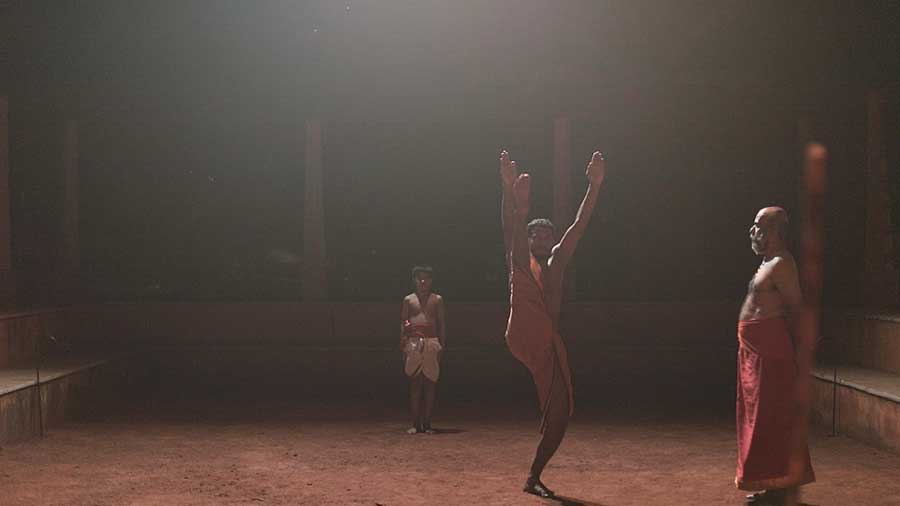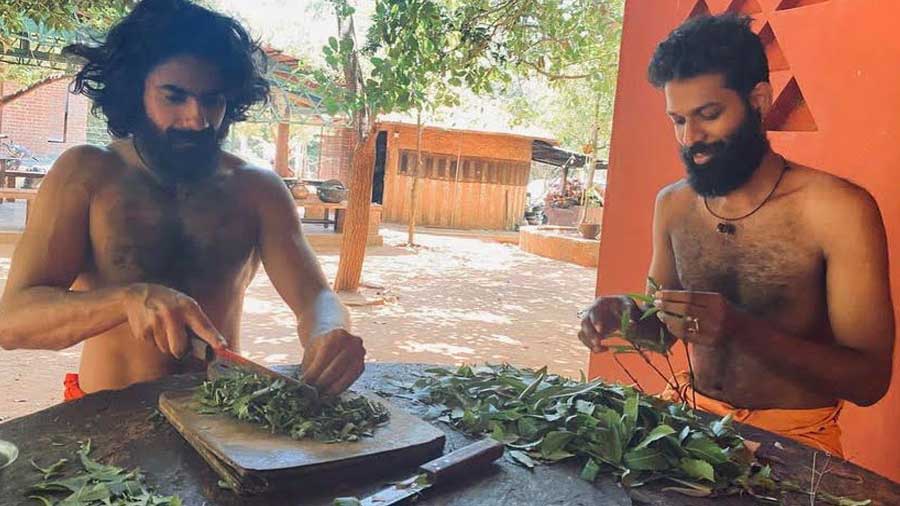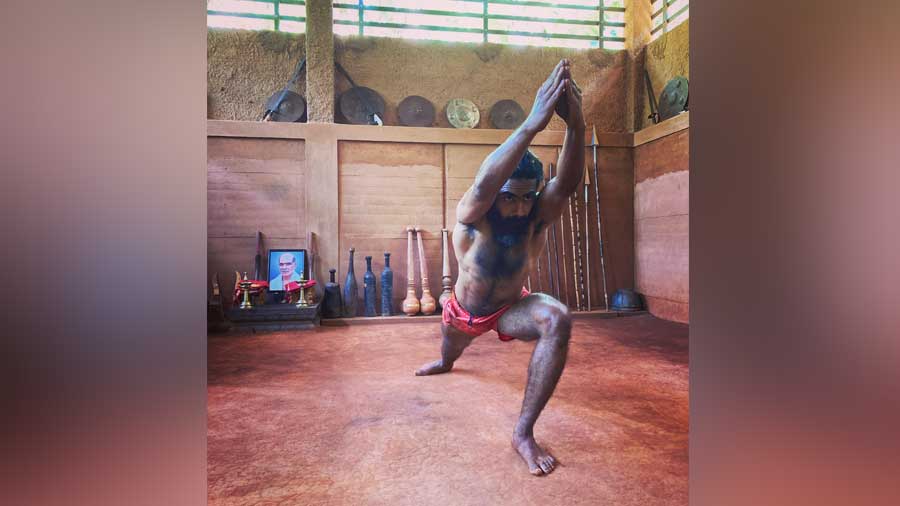Kalaripayattu is largely regarded as one of the world’s oldest martial art forms. While there’s no clear record of its origin, there are many stories attached to it, especially in its birthplace, Kerala. Some believe Kalaripayattu has roots in mythology, but most historians agree that it was born sometime in the Sangam period between 200 and 600 B.C. In recent times it has gained popularity again as a fitness regime with a spiritual bend.

The 'poothara' at the training area in Kalarigram Farawayoriginals
Tradition and ritual are important to Kalaripayattu. A seven-tiered, tapering platform called poothara stands on the southwest corner of the training arena or kalari. It is said to symbolise the seven chakras of the human body, but at most kalaris it is also the altar for patron goddess Bhadrakali. Often, other gods including Shiva, Parvati, Ganapati, Ayyappa, and serpent deities are also worshipped. Kalaripayattu training is rooted in ancient Indian traditions and beliefs as well. Daily training focusing on flexibility, strength, power, balance and coordination is aimed to transform the practitioner’s physical body or sthula sharira as well as the subtle or astral body, known as the sukshma sharira. This establishes balance between the three humours, or tridosa which are vana (wind), kapha (phlegm), and pitta (fire).

'Meipayattu' are coordinated dance-like sequences
Kalarigram is a traditional Kalaripayattu centre located near Auroville in Tamil Nadu. It was founded by Shri Lakshmanan Gurukkal in 2010 to spread awareness on this martial art form. The centre conducts Ayurveda, yoga and meditation workshops as well. They also host artistes from around the world who are invited to perform at their open-air theatres.

Training at the kalari Farawayoriginals
The area where Kalaripayattu training is conducted is known as the kalari, which is also the Tamil and Malayalam word for ‘battlefield’. The simple, rectangular room is created by digging a six-foot-deep trench. From the time the site is selected, through the construction of the kalari and inauguration, certain rituals are performed to ensure an appropriate atmosphere as well as the protection and well-being of all who enter the kalari. As Shri Lakshmanan Gurukkal says, “Entering the pit is like getting back to your mother’s womb. A place where you are safe and protected while you go through a process of self-transformation by plugging-in into Mother Earth’s infinite energy. It’s a place where the microcosm meets the macrocosm.” Many in modern times refer to this idea as earthing or grounding. It involves contact with the earth’s natural electromagnetic charge by walking barefoot or sitting on the ground. It is believed to stabilise our physiology by reducing inflammation, pain and stress, and improving blood flow. A kalari is made within the southwest corner of a plot, must face the auspicious East and has five steps, representing the five elements of water, earth, fire, air and space, leading to the pit.

'Kalari vandanam' performed in reverence to the guardian deity Imran Sarfaraz
Kalaripayattu training starts with the most important sequence known as puttara tol or kalari vandanam. These sequences are performed in reverence to kalari’s guardian deity, and crucial in developing a way of devotion as well as awakening the subtle body.
Physical training for the form, often also referred to as Kalari as well, begins with a series of kicks and leg exercises or kal etupp. These are essential for flexibility and balance, as well as to improve a student’s visual focus. They are told to focus at one particular point during the entire training session. This is the initial step in developing focus or ekagrata and awakening the subtle body.

A series of stances, postures and leg exercises help develop flexibility, balance and control Farawayoriginals
The preliminary training of Kalaripayattu involves learning chuvada, vadiyu and kal etupp, a series of stances, postures and leg exercises to develop flexibility, balance and control. Once the body achieves a minimal level of balance and coordination, the students are introduced to meipayattu, which are dance-like coordinated sequences. The graceful, fluid movements belie the strength behind them, which can translate to lightning-fast blows. It is only when a student is physically, spiritually and ethically ready that they are allowed to take up the weapons.

Revathi Gurukkal demonstrating the 'Gaja Vadivu' Imran Sarfaraz
A teacher of Kalaripayattu is referred to as Gurukkal. Revathi Gurukkal is one of the instructors at Kalarigram. Here, she demonstrates the pose, Gaja Vadivu. Gaja means elephant, and this posture is designed to ground a warrior deep into the earth. A student who masters this position is said to develop the strength and stability of an elephant, and is not easily toppled by an opponent.

Making the herbal massage oil Imran Sarfaraz
A specially prepared, herb-infused oil is applied before exercise. Kalari exponents also have regular massage sessions following the Kerala ayurvedic healing techniques. This is supposed to aid in the flexibility and strength of the body. Applying oil before training also helps keep the body warm by not allowing heat to dissipate.

Kalaripayattu follows the guru-shishya tradition Imran Sarfaraz
Kalaripayattu follows the traditional Guru-shishya parampara. The process of training a student is compared to that of growing a sapling. The seed of Kalaripayattu is planted by the Guru during initiation. From then on, it's the duty of the shishya (student) to nurture this seed of knowledge with regular practice and by following the rituals associated with Kalari. It is believed that the rituals associated with the initiation or invitation clears any obstacles in the way of successful completion of the lessons.

Kalaripayattu can help one grow physically, mentally and spiritually Imran Sarfaraz
The four months spent at Kalarigram, training almost five hours a day, made me realise that Kalarippayattu is not just a martial art. It is moving meditation that can help us grow physically, mentally and spiritually. The physical training made me aware not only of my true potential but also mental and physical barriers. Instead of shying away from such blocks, we started addressing them and each of us became more comfortable in our bodies. Coming from a Western educational system, it was surprising to learn how holistic this ancient martial art form is. From the geometry of the pit to each pose practiced in Kalari, there is a science behind it all. Ekagrata teaches one to stay focused in the moment, and for those five hours every day all I could focus on was the movement of my body and breath. The positive health benefits of this form have attracted people from all walks of life—from movement practitioners like me, to dancers, theatre artists and actors.
